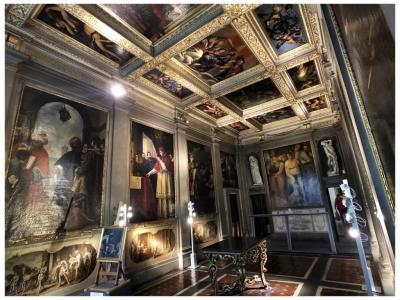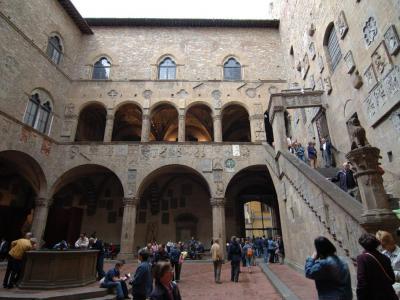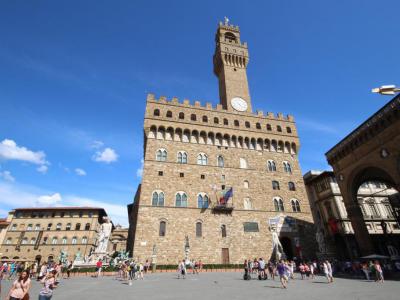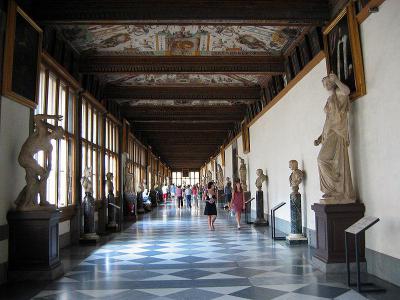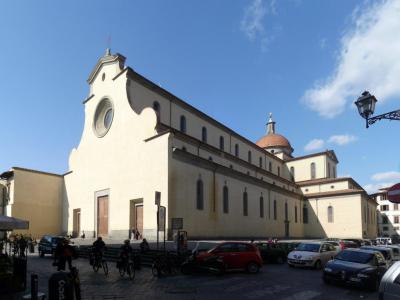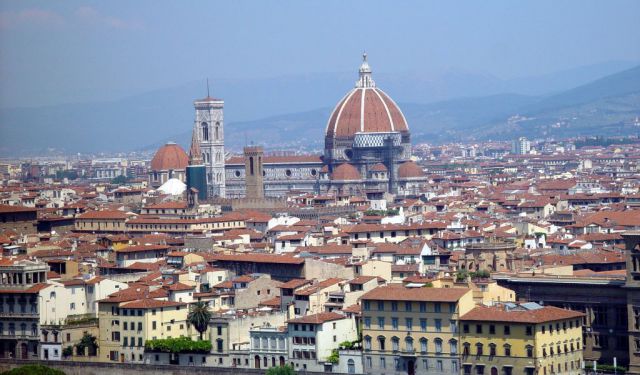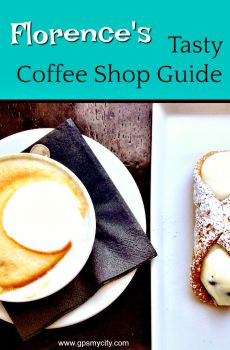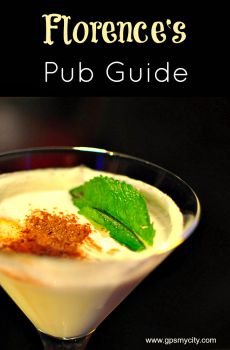Audio Guide: Michelangelo's Masterpieces Walking Tour (Self Guided), Florence
Though born in the small Tuscan town of Caprese, Michelangelo spent over two decades of his life in Florence-the heart of the Renaissance. It was here that he grew up, was educated, and began shaping his artistic voice, eventually creating some of the most iconic masterpieces the city has ever known.
His larger-than-life work-“David”-didn’t just reshape the image of biblical heroism-it redefined what sculpture could be. No photograph, postcard, or replica can capture the weight, detail, or presence of the real thing. So why not begin your journey by heading to the Gallery of the Academy and seeing it with your own eyes?
From there, continue through Florence and trace the legacy of the master in stone. At the Bargello Museum, you’ll find other remarkable works: “Bacchus,” “Madonna and Child,” “Brutus,” and “David-Apollo.” The Old Palace displays “The Genius of Victory”, a dynamic marble figure that almost seems to move. At the Uffizi, you’ll get to see the circular “Doni Tondo”-his only known finished panel painting. Meanwhile, the Museum of the Cathedral’s Works houses “The Deposition,” a deeply personal sculpture that Michelangelo began in his seventies, possibly intending it for his own tomb.
A visit to Casa Buonarroti, the home once owned by the artist, reveals his earliest triumphs-the relief “Madonna of the Steps,” carved at fifteen, and the “Battle of the Centaurs,” completed before he turned seventeen. These youthful works already show the fierce motion and tension that would define his style.
Don’t skip the city’s churches. Beneath the Medici Chapel at San Lorenzo lies a hidden chamber where, in 1530, Michelangelo took refuge during political upheaval. The Medici shaped much of his early career, supported his artistic rise, and later contributed to his exile. The Basilica of the Holy Cross, where his ashes now rest among giants like Galileo and Machiavelli, offers a moment of reflection at the journey’s end.
So take a deep breath, lace up your shoes, and follow the footsteps of a legend. Let this self-guided walk pull you through Florence-not just across its streets, but through time, across marble and memory, into the heart of Michelangelo’s immortal world.
His larger-than-life work-“David”-didn’t just reshape the image of biblical heroism-it redefined what sculpture could be. No photograph, postcard, or replica can capture the weight, detail, or presence of the real thing. So why not begin your journey by heading to the Gallery of the Academy and seeing it with your own eyes?
From there, continue through Florence and trace the legacy of the master in stone. At the Bargello Museum, you’ll find other remarkable works: “Bacchus,” “Madonna and Child,” “Brutus,” and “David-Apollo.” The Old Palace displays “The Genius of Victory”, a dynamic marble figure that almost seems to move. At the Uffizi, you’ll get to see the circular “Doni Tondo”-his only known finished panel painting. Meanwhile, the Museum of the Cathedral’s Works houses “The Deposition,” a deeply personal sculpture that Michelangelo began in his seventies, possibly intending it for his own tomb.
A visit to Casa Buonarroti, the home once owned by the artist, reveals his earliest triumphs-the relief “Madonna of the Steps,” carved at fifteen, and the “Battle of the Centaurs,” completed before he turned seventeen. These youthful works already show the fierce motion and tension that would define his style.
Don’t skip the city’s churches. Beneath the Medici Chapel at San Lorenzo lies a hidden chamber where, in 1530, Michelangelo took refuge during political upheaval. The Medici shaped much of his early career, supported his artistic rise, and later contributed to his exile. The Basilica of the Holy Cross, where his ashes now rest among giants like Galileo and Machiavelli, offers a moment of reflection at the journey’s end.
So take a deep breath, lace up your shoes, and follow the footsteps of a legend. Let this self-guided walk pull you through Florence-not just across its streets, but through time, across marble and memory, into the heart of Michelangelo’s immortal world.
How it works: Download the app "GPSmyCity: Walks in 1K+ Cities" from Apple App Store or Google Play Store to your mobile phone or tablet. The app turns your mobile device into a personal tour guide and its built-in GPS navigation functions guide you from one tour stop to next. The app works offline, so no data plan is needed when traveling abroad.
Michelangelo's Masterpieces Walking Tour Map
Guide Name: Michelangelo's Masterpieces Walking Tour
Guide Location: Italy » Florence (See other walking tours in Florence)
Guide Type: Self-guided Walking Tour (Sightseeing)
# of Attractions: 9
Tour Duration: 2 Hour(s)
Travel Distance: 4.0 Km or 2.5 Miles
Author: greghasleft
Sight(s) Featured in This Guide:
Guide Location: Italy » Florence (See other walking tours in Florence)
Guide Type: Self-guided Walking Tour (Sightseeing)
# of Attractions: 9
Tour Duration: 2 Hour(s)
Travel Distance: 4.0 Km or 2.5 Miles
Author: greghasleft
Sight(s) Featured in This Guide:
- Galleria dell'Accademia (Gallery of the Academy of Florence)
- Basilica di San Lorenzo (Basilica of St. Lawrence)
- Museo dell'Opera del Duomo (Museum of the Works of the Cathedral)
- Casa Buonarroti (Michelangelo Buonarroti House-Museum)
- Basilica di Santa Croce (Basilica of the Holy Cross)
- Palazzo del Bargello (Bargello National Museum)
- Palazzo Vecchio (Old Palace)
- Galleria degli Uffizi (Uffizi Gallery)
- Basilica di Santo Spirito (Basilica of the Holy Spirit)
1) Galleria dell'Accademia (Gallery of the Academy of Florence) (must see)
Tucked beside Florence’s Academy of Fine Arts, this gallery is smaller and more focused than the Uffizi-but no less impressive. Despite the name, it’s not formally tied to the Academy itself. What you’ll find here is a rich concentration of Florentine paintings, primarily from the 14th to 16th centuries, by artists like Uccello, Ghirlandaio, or Botticelli. There’s also a striking collection of plaster sculptures by Bartolini, Pampaloni, and Giambologna.
But the true magnet is Michelangelo’s original “David”, a striking masterpiece that anchors the entire visit. Leading up to it is a series of unfinished works by Michelangelo that are beautiful in their own right-among them the four “Prisoners” and a dramatic “Compassion”. These partial figures reveal the raw, emotional intensity of his process: you can still see the grooves left by mallet and chisel. And “David”, of course, has transcended the gallery, replicated endlessly-from beachfront resorts to casino lobbies-yet none compare to the sheer impact of seeing the original in person.
Elsewhere in the gallery, a dedicated room displays gleaming gold-ground polyptychs, rescued from churches around the region. Upstairs, you’ll discover a fascinating textile exhibit featuring fabrics and tapestries from the 13th and 14th centuries. Don’t skip the musical instrument section-it’s a treasure. Highlights include stringed instruments by Casini, Amati, and Stradivari, along with rare harpsichords. Each display comes with a detailed description, and some offer audio commentary at the push of a button.
Tip: During peak travel seasons, try visiting on a Tuesday or Thursday evening-the gallery stays open late, and the lines tend to be shorter. If you pre-book your ticket online, just remember to head across the street to the designated doorway to exchange your confirmation for an actual ticket. The guards outside will point you in the right direction.
But the true magnet is Michelangelo’s original “David”, a striking masterpiece that anchors the entire visit. Leading up to it is a series of unfinished works by Michelangelo that are beautiful in their own right-among them the four “Prisoners” and a dramatic “Compassion”. These partial figures reveal the raw, emotional intensity of his process: you can still see the grooves left by mallet and chisel. And “David”, of course, has transcended the gallery, replicated endlessly-from beachfront resorts to casino lobbies-yet none compare to the sheer impact of seeing the original in person.
Elsewhere in the gallery, a dedicated room displays gleaming gold-ground polyptychs, rescued from churches around the region. Upstairs, you’ll discover a fascinating textile exhibit featuring fabrics and tapestries from the 13th and 14th centuries. Don’t skip the musical instrument section-it’s a treasure. Highlights include stringed instruments by Casini, Amati, and Stradivari, along with rare harpsichords. Each display comes with a detailed description, and some offer audio commentary at the push of a button.
Tip: During peak travel seasons, try visiting on a Tuesday or Thursday evening-the gallery stays open late, and the lines tend to be shorter. If you pre-book your ticket online, just remember to head across the street to the designated doorway to exchange your confirmation for an actual ticket. The guards outside will point you in the right direction.
2) Basilica di San Lorenzo (Basilica of St. Lawrence) (must see)
Amidst the lively atmosphere of Florence’s Central Market stands one of the city's oldest and most historically significant churches-San Lorenzo. Thought to have been founded in the late Roman era, it’s also the city’s largest basilica. While the rough, unfinished exterior may not draw immediate attention, the interior reveals the grandeur befitting the primary place of worship and final resting site for the powerful Medici dynasty.
The Medicis commissioned none other than the brilliant Brunelleschi to redesign the church in line with the modern Renaissance style. Meanwhile, Michelangelo was tasked with creating an elaborate marble façade. Unfortunately, the death of both Brunelleschi and Giovanni de’ Medici halted progress, leaving Michelangelo to bear the frustration of an unfulfilled vision. Still, he managed to design the internal façade, visible when you turn to look toward the main entrance from the nave.
Step through the church’s doors and you’ll be surrounded by the elegance of Renaissance design: clean lines, grey-and-white columns, and marble detailing that leads to the altar, which marks the tomb of Florence’s first Medici ruler. Donatello’s final works, a pair of bronze pulpits, can be spotted along the central nave, and both he and Cosimo de’ Medici are interred in the crypt. Nearby, Michelangelo’s New Sacristy holds sculpted tombs with allegorical figures of Night and Day, Dusk and Dawn.
The adjacent Chapel of the Princes also impresses with its monumental dome and exquisite fresco arrangements-a grand expression of Medici power. Add in the cloisters, peaceful gardens, and the Laurentian Library-also attributed to Michelangelo-and you’ve got a rare haven of art, architecture, and calm in the heart of Florence.
Tip: Keep in mind that each area has its own entrance, and separate admission is required-unless you have the Florence Card. Note that both the Chapel of the Princes and the New Sacristy close in the early afternoon, so plan accordingly. When you're done exploring, grab a table near the Central Market for a relaxed drink or bite and soak up the atmosphere of the square.
The Medicis commissioned none other than the brilliant Brunelleschi to redesign the church in line with the modern Renaissance style. Meanwhile, Michelangelo was tasked with creating an elaborate marble façade. Unfortunately, the death of both Brunelleschi and Giovanni de’ Medici halted progress, leaving Michelangelo to bear the frustration of an unfulfilled vision. Still, he managed to design the internal façade, visible when you turn to look toward the main entrance from the nave.
Step through the church’s doors and you’ll be surrounded by the elegance of Renaissance design: clean lines, grey-and-white columns, and marble detailing that leads to the altar, which marks the tomb of Florence’s first Medici ruler. Donatello’s final works, a pair of bronze pulpits, can be spotted along the central nave, and both he and Cosimo de’ Medici are interred in the crypt. Nearby, Michelangelo’s New Sacristy holds sculpted tombs with allegorical figures of Night and Day, Dusk and Dawn.
The adjacent Chapel of the Princes also impresses with its monumental dome and exquisite fresco arrangements-a grand expression of Medici power. Add in the cloisters, peaceful gardens, and the Laurentian Library-also attributed to Michelangelo-and you’ve got a rare haven of art, architecture, and calm in the heart of Florence.
Tip: Keep in mind that each area has its own entrance, and separate admission is required-unless you have the Florence Card. Note that both the Chapel of the Princes and the New Sacristy close in the early afternoon, so plan accordingly. When you're done exploring, grab a table near the Central Market for a relaxed drink or bite and soak up the atmosphere of the square.
3) Museo dell'Opera del Duomo (Museum of the Works of the Cathedral) (must see)
If you’re visiting the Duomo, skipping this nearby museum would be a serious oversight. It tends to fly under the radar, given Florence's overwhelming list of must-see attractions-but there are quite a few things to like here. You’ll find fewer crowds, an easy-to-navigate layout, and thoughtfully spaced exhibits that invite close, uninterrupted viewing. Modern in design and, refreshingly, air-conditioned, the museum offers a calm, cool retreat for art lovers.
Many of the sculptures and architectural elements you see around the Duomo are actually replicas. This place is home to the originals, preserved for future generations. One of the most striking displays is the life-size reconstruction of the cathedral’s early façade-an immense installation packed with original details, including the enormous golden door that’s particularly unforgettable.
Michelangelo’s “The Deposition”-is another highlight, also known as “Lamentation over the Dead Christ”. Unlike his famous Roman version in Saint Peter’s Basilica, this one has a raw, unfinished energy. Carved toward the end of his life, the work was abandoned when Michelangelo consumed the marble through relentless chiseling. What remains feels almost modern in its abstraction, as if it were channeling the spirit of future centuries.
The museum also houses original pieces from the Baptistery and Giotto’s Bell Tower, all beautifully lit and arranged for close inspection. Benches are thoughtfully placed, allowing you to sit and absorb the detail without craning your neck like you might outside in the square.
The entire collection can be easily covered in about two hours-though art lovers may want to linger. Descriptions are available in both Italian and English, making it easy to guide yourself through.
Tip: Make sure not to miss the rooftop terrace-it offers one of the best vantage points for admiring the Duomo.
Many of the sculptures and architectural elements you see around the Duomo are actually replicas. This place is home to the originals, preserved for future generations. One of the most striking displays is the life-size reconstruction of the cathedral’s early façade-an immense installation packed with original details, including the enormous golden door that’s particularly unforgettable.
Michelangelo’s “The Deposition”-is another highlight, also known as “Lamentation over the Dead Christ”. Unlike his famous Roman version in Saint Peter’s Basilica, this one has a raw, unfinished energy. Carved toward the end of his life, the work was abandoned when Michelangelo consumed the marble through relentless chiseling. What remains feels almost modern in its abstraction, as if it were channeling the spirit of future centuries.
The museum also houses original pieces from the Baptistery and Giotto’s Bell Tower, all beautifully lit and arranged for close inspection. Benches are thoughtfully placed, allowing you to sit and absorb the detail without craning your neck like you might outside in the square.
The entire collection can be easily covered in about two hours-though art lovers may want to linger. Descriptions are available in both Italian and English, making it easy to guide yourself through.
Tip: Make sure not to miss the rooftop terrace-it offers one of the best vantage points for admiring the Duomo.
4) Casa Buonarroti (Michelangelo Buonarroti House-Museum)
Just a short stroll from Santa Croce Square, but away from the crowds, the Buonarroti House offers a quiet, intimate space to reflect on the legacy of Michelangelo. Originally owned by the artist himself and passed down through his nephew Leonardo, it was his great-nephew-Michelangelo Buonarroti the Younger-who transformed the property into a loving tribute to one of the Renaissance era’s greatest minds.
While photography is not allowed, visitors are welcome to linger near two of Michelangelo’s earliest surviving sculptures. You’ll also see his wooden architectural model for what was meant to be the grand marble façade of the Basilica of Saint Lawrence-an ambitious project he was later denied, a loss he reportedly never got over.
The two early sculptural works to see here are “Madonna of the Stairs”, believed to be carved at age 15 and clearly influenced by Donatello, and “Battle of the Centaurs”, completed around age 17, where Michelangelo broke away from classical form and dove into his own expressive style. He valued this second piece so much that he kept it for the rest of his life.
Beyond the sculptures, the museum holds more than 200 restored drawings, letters, sketches, and personal objects-among them a sword, walking sticks, a pair of well-worn shoes, and even a possible self-portrait. Later generations added to the collection, including paintings that narrate key moments from Michelangelo’s life and career.
Tip: If you're planning to visit the Santa Croce complex, consider getting the combined ticket-it’s a great way to connect the dots between Florence’s artistic giants.
While photography is not allowed, visitors are welcome to linger near two of Michelangelo’s earliest surviving sculptures. You’ll also see his wooden architectural model for what was meant to be the grand marble façade of the Basilica of Saint Lawrence-an ambitious project he was later denied, a loss he reportedly never got over.
The two early sculptural works to see here are “Madonna of the Stairs”, believed to be carved at age 15 and clearly influenced by Donatello, and “Battle of the Centaurs”, completed around age 17, where Michelangelo broke away from classical form and dove into his own expressive style. He valued this second piece so much that he kept it for the rest of his life.
Beyond the sculptures, the museum holds more than 200 restored drawings, letters, sketches, and personal objects-among them a sword, walking sticks, a pair of well-worn shoes, and even a possible self-portrait. Later generations added to the collection, including paintings that narrate key moments from Michelangelo’s life and career.
Tip: If you're planning to visit the Santa Croce complex, consider getting the combined ticket-it’s a great way to connect the dots between Florence’s artistic giants.
5) Basilica di Santa Croce (Basilica of the Holy Cross) (must see)
Santa Croce is one of the most celebrated Franciscan churches in the world and a jewel of Gothic architecture in Florence. Built over the 13th and 14th centuries, it’s often called the “Temple of Italian Glories”-and for good reason. This is where some of Italy’s greatest minds and artists are buried-among them Michelangelo, Galileo, Machiavelli, the poet Foscolo, and the composer Rossini.
Michelangelo’s journey back to Florence after death is itself the stuff of legend. Though he died in Rome, Cosimo de’ Medici made sure his remains returned home. The Medici ruler, unable to properly honor the artist in life, vowed to do so in death-and, to this end, commissioned an elaborate tomb. Designed by Giorgio Vasari, the tomb took 14 years to complete and features symbols tied to Michelangelo’s creative legacy. Three laurel wreaths represent his mastery of painting, sculpture, and architecture, each mourned by a figure carved in deep sorrow below his bust.
Galileo’s story follows a similarly complicated path. Though he died in 1642, his tomb wasn’t built until nearly a century later, in 1737, now facing Michelangelo’s across the nave. It’s adorned with allegorical figures representing Astronomy and Geometry, and quietly also includes the tomb of his daughter, Maria Celeste-though her presence often goes unnoticed.
Dante, however, remains absent. While Florence tried for years to reclaim his remains, the poet still lies in Ravenna, the city that welcomed him after exile. Here in Santa Croce, an empty sarcophagus stands in his honor, and a grand statue was erected outside the church in 1865 for his 600th birth anniversary.
The interior is filled with masterpieces by Giotto, Donatello, Vasari, Canova, and others too numerous to list in one breath. Outside, the tranquil cloisters and green courtyard offer a quiet space to pause or sketch, while the square hosts everything from live concerts to raucous games of Florentine “rugby.”
Tip: Be sure to stop by the Leather School just behind the church. You can watch apprentices at work and maybe find a unique handmade piece to take home. Just remember: modest attire is required-no bare shoulders or short shorts, especially for women, as the dress code is firmly enforced.
Michelangelo’s journey back to Florence after death is itself the stuff of legend. Though he died in Rome, Cosimo de’ Medici made sure his remains returned home. The Medici ruler, unable to properly honor the artist in life, vowed to do so in death-and, to this end, commissioned an elaborate tomb. Designed by Giorgio Vasari, the tomb took 14 years to complete and features symbols tied to Michelangelo’s creative legacy. Three laurel wreaths represent his mastery of painting, sculpture, and architecture, each mourned by a figure carved in deep sorrow below his bust.
Galileo’s story follows a similarly complicated path. Though he died in 1642, his tomb wasn’t built until nearly a century later, in 1737, now facing Michelangelo’s across the nave. It’s adorned with allegorical figures representing Astronomy and Geometry, and quietly also includes the tomb of his daughter, Maria Celeste-though her presence often goes unnoticed.
Dante, however, remains absent. While Florence tried for years to reclaim his remains, the poet still lies in Ravenna, the city that welcomed him after exile. Here in Santa Croce, an empty sarcophagus stands in his honor, and a grand statue was erected outside the church in 1865 for his 600th birth anniversary.
The interior is filled with masterpieces by Giotto, Donatello, Vasari, Canova, and others too numerous to list in one breath. Outside, the tranquil cloisters and green courtyard offer a quiet space to pause or sketch, while the square hosts everything from live concerts to raucous games of Florentine “rugby.”
Tip: Be sure to stop by the Leather School just behind the church. You can watch apprentices at work and maybe find a unique handmade piece to take home. Just remember: modest attire is required-no bare shoulders or short shorts, especially for women, as the dress code is firmly enforced.
6) Palazzo del Bargello (Bargello National Museum) (must see)
Florence is a haven for architecture enthusiasts and art lovers, and the Bargello Museum elevates this experience even further. Set within the walls of a medieval fortress, the museum houses some of Italy’s most prized sculptures and artworks.
Also known as the People’s Palace, the Bargello dates back to 1255, making it one of Florence’s oldest surviving structures. Over the centuries, it’s served many roles-starting in the 16th century, when it housed Florence’s chief of police, also called the “bargello.” Later, it functioned as a prison before finally being transformed into a museum in the mid-19th century. Since then, it’s become the ultimate destination for Gothic and Renaissance sculpture.
Inside, you’ll encounter masterpieces by iconic artists like Michelangelo, Donatello, Verrocchio, and Brunelleschi, to name just a few. One of the museum’s most celebrated pieces is Donatello’s “David”, a landmark work that became the first male nude sculpture publicly displayed since ancient times-marking a turning point in European art. Michelangelo’s contributions include “Bacchus”, “Pitti Tondo” (also known as “Madonna and Child”), “Brutus”, and “David-Apollo”. “Bacchus”, which Michelangelo carved at just 22 years old, is particularly striking. The figure’s rolling eyes and teetering posture give it an almost lifelike instability, reflecting a daringly androgynous quality that marked a bold step in the artist’s early career.
Beyond the Renaissance sculptures, the museum offers treasures from the Byzantine, Roman, and Medieval periods. You’ll also find exquisite jewelry-some pieces from the European Renaissance, others with Islamic origins. English descriptions accompany all exhibits, making the experience both accessible and informative.
Tip: Check the museum’s website ahead of time for opening hours. On certain days, the Bargello stays open late, giving visitors the chance to explore the medieval setting in a peaceful, near-empty atmosphere. It’s an unforgettable way to experience these works of art.
Also known as the People’s Palace, the Bargello dates back to 1255, making it one of Florence’s oldest surviving structures. Over the centuries, it’s served many roles-starting in the 16th century, when it housed Florence’s chief of police, also called the “bargello.” Later, it functioned as a prison before finally being transformed into a museum in the mid-19th century. Since then, it’s become the ultimate destination for Gothic and Renaissance sculpture.
Inside, you’ll encounter masterpieces by iconic artists like Michelangelo, Donatello, Verrocchio, and Brunelleschi, to name just a few. One of the museum’s most celebrated pieces is Donatello’s “David”, a landmark work that became the first male nude sculpture publicly displayed since ancient times-marking a turning point in European art. Michelangelo’s contributions include “Bacchus”, “Pitti Tondo” (also known as “Madonna and Child”), “Brutus”, and “David-Apollo”. “Bacchus”, which Michelangelo carved at just 22 years old, is particularly striking. The figure’s rolling eyes and teetering posture give it an almost lifelike instability, reflecting a daringly androgynous quality that marked a bold step in the artist’s early career.
Beyond the Renaissance sculptures, the museum offers treasures from the Byzantine, Roman, and Medieval periods. You’ll also find exquisite jewelry-some pieces from the European Renaissance, others with Islamic origins. English descriptions accompany all exhibits, making the experience both accessible and informative.
Tip: Check the museum’s website ahead of time for opening hours. On certain days, the Bargello stays open late, giving visitors the chance to explore the medieval setting in a peaceful, near-empty atmosphere. It’s an unforgettable way to experience these works of art.
7) Palazzo Vecchio (Old Palace) (must see)
Just like the Cathedral complex and Florence’s world-class galleries, the Old Palace is essential for anyone wanting to grasp the city's history and cultural identity. This massive Romanesque fortress is one of the most striking town halls in all of Tuscany. Since 1872, it has served as the office of Florence’s mayor, but its legacy stretches much further back. Built in 1299, the edifice was the political heart of the Florentine Republic for centuries. When Cosimo de’ Medici moved in with his family in 1540 as Grand Duke, he had it expanded and transformed, blending its medieval bones with elegant Renaissance flair.
The rugged stone façade, lined with shields chronicling Florence’s political past, is also home to an impressive lineup of statues. These include Florence’s heraldic symbol- the Marzocco lion, along with Donatello’s powerful “Judith and Holofernes”, and “Hercules and Cacus”. The nearby Tower of Arnolfo, rising above the palace, offers a climbable vantage point-though access requires a separate ticket.
Meanwhile, inside, every room tells a chapter of the city’s history. You’ll walk through the spectacular Hall of the Five Hundred, designed to glorify Medici rule, and into the more private quarters where the family lived. Decorated under the artistic direction of Giorgio Vasari, these spaces are rich in symbolism and political narrative. Give yourself time to move slowly through the rooms-it’s an immersive dive into Florentine grandeur. And be warned: you may leave with a crick in your neck from gazing.
One standout work here is Michelangelo’s “Genius of Victory”. Originally meant for the tomb of Pope Julius II, the sculpture depicts a young, triumphant figure standing over a defeated older man. The contrast between the two is striking-the victor is smooth and polished, the vanquished figure unfinished and rough, still bearing the weight of the stone.
You’ll also come across something rather haunting-a death mask of Dante Alighieri, displayed between the Apartments of Eleanor and the Halls of the Priors. Though the poet was buried in Ravenna, this plaster cast has become a powerful reminder of his influence on Florence, both politically and culturally. Fans of Dan Brown’s “Inferno” will surely recognize it from the novel.
Tip: If you’re planning a guided visit, it’s best to book directly with the museum by email-include your preferred date and time, and wait for confirmation. Payment is made on the day of your tour, and afterward, you’re free to continue exploring on your own. Just keep in mind: because this is still a working municipal building, access may occasionally be restricted. It’s a good idea to check the official website before you go.
The rugged stone façade, lined with shields chronicling Florence’s political past, is also home to an impressive lineup of statues. These include Florence’s heraldic symbol- the Marzocco lion, along with Donatello’s powerful “Judith and Holofernes”, and “Hercules and Cacus”. The nearby Tower of Arnolfo, rising above the palace, offers a climbable vantage point-though access requires a separate ticket.
Meanwhile, inside, every room tells a chapter of the city’s history. You’ll walk through the spectacular Hall of the Five Hundred, designed to glorify Medici rule, and into the more private quarters where the family lived. Decorated under the artistic direction of Giorgio Vasari, these spaces are rich in symbolism and political narrative. Give yourself time to move slowly through the rooms-it’s an immersive dive into Florentine grandeur. And be warned: you may leave with a crick in your neck from gazing.
One standout work here is Michelangelo’s “Genius of Victory”. Originally meant for the tomb of Pope Julius II, the sculpture depicts a young, triumphant figure standing over a defeated older man. The contrast between the two is striking-the victor is smooth and polished, the vanquished figure unfinished and rough, still bearing the weight of the stone.
You’ll also come across something rather haunting-a death mask of Dante Alighieri, displayed between the Apartments of Eleanor and the Halls of the Priors. Though the poet was buried in Ravenna, this plaster cast has become a powerful reminder of his influence on Florence, both politically and culturally. Fans of Dan Brown’s “Inferno” will surely recognize it from the novel.
Tip: If you’re planning a guided visit, it’s best to book directly with the museum by email-include your preferred date and time, and wait for confirmation. Payment is made on the day of your tour, and afterward, you’re free to continue exploring on your own. Just keep in mind: because this is still a working municipal building, access may occasionally be restricted. It’s a good idea to check the official website before you go.
8) Galleria degli Uffizi (Uffizi Gallery) (must see)
If you could only visit one Renaissance landmark in Florence-or even the entire world-the Uffizi Gallery would be the top contender. Originally designed as government offices for the magistrates of Florence, this grand building was commissioned in the 16th century by Cosimo de’ Medici and brought to life by Giorgio Vasari. Though built for administrative purposes, the palace quickly evolved into the perfect setting for the Medici family’s extraordinary art collection. By 1765, the gallery opened its doors to the public and has since become one of Florence’s most visited museums.
Here, you’ll come face-to-face with some of the most iconic works in art history. Highlights include Sandro Botticelli’s “Birth of Venus” and “Adoration of the Magi”, as well as masterpieces by Leonardo da Vinci, Michelangelo, and Caravaggio. One of Michelangelo’s works displayed is “Doni Tondo”-a circular painting nearly four feet across that depicts the Holy Family. Created in 1504, it gives us an early glimpse of the vibrant palette the artist would later use in his frescoes on the Sistine Chapel ceiling.
While paintings and sculptures are the main attraction, don’t overlook the gallery’s interior design. The ceilings are intricately decorated, and each room carries its own sense of grandeur. With more than 50 opulent rooms to wander through, it’s easy to feel overwhelmed. That’s why a break at the rooftop café is a smart move. Grab a coffee, rest your feet, and soak in the stunning views of Florence that you won’t find anywhere else.
Because of its global fame, the Uffizi is rarely quiet. Expect long lines, especially during high season. Booking your ticket in advance through the official website is highly recommended-it will save you time, and you might even catch a discount. And one last note before you go: no liquids are allowed inside, so plan accordingly.
Here, you’ll come face-to-face with some of the most iconic works in art history. Highlights include Sandro Botticelli’s “Birth of Venus” and “Adoration of the Magi”, as well as masterpieces by Leonardo da Vinci, Michelangelo, and Caravaggio. One of Michelangelo’s works displayed is “Doni Tondo”-a circular painting nearly four feet across that depicts the Holy Family. Created in 1504, it gives us an early glimpse of the vibrant palette the artist would later use in his frescoes on the Sistine Chapel ceiling.
While paintings and sculptures are the main attraction, don’t overlook the gallery’s interior design. The ceilings are intricately decorated, and each room carries its own sense of grandeur. With more than 50 opulent rooms to wander through, it’s easy to feel overwhelmed. That’s why a break at the rooftop café is a smart move. Grab a coffee, rest your feet, and soak in the stunning views of Florence that you won’t find anywhere else.
Because of its global fame, the Uffizi is rarely quiet. Expect long lines, especially during high season. Booking your ticket in advance through the official website is highly recommended-it will save you time, and you might even catch a discount. And one last note before you go: no liquids are allowed inside, so plan accordingly.
9) Basilica di Santo Spirito (Basilica of the Holy Spirit)
Here we have yet another Florence landmark linked to the brilliant Renaissance architect-Filippo Brunelleschi. At first glance, the plain façade may not look too impressive, but step inside, and the story changes completely. The interior reveals a plethora of Baroque embellishments, crowned by a colorful Baldachin above the elevated altar. Along the entire perimeter, forty uniform side chapels-set like niches-house a remarkable collection of Renaissance art, featuring works by masters like Sansovino and Rosselli. Some of the restored pieces are especially vivid, with colors and detail that practically leap from the walls.
For a small fee, you can explore the two cloisters, where the walls are lined with historic tombstones and impressive Late Gothic frescoes. You’ll also find sculptures spanning the 11th to 15th centuries, including low reliefs by Donatello, a high relief of the Madonna and Child, and two graceful marble figures carved by Tino da Camaino in the early 1300s.
Tucked away in a side chapel is a very special find-the wooden crucifix carved by a young Michelangelo, long before he made his mark in Rome. Just seventeen at the time, he was granted permission to study anatomy using cadavers from the convent’s hospital. In return, he created this delicate crucifix, initially placed above the high altar. Today, it resides in the octagonal sacristy, which you can reach from the church’s western aisle. While you're there, take a moment to admire faithful reproductions of his later works-“Pietà” and “Christ”-both remarkable in their own right.
Tip: Don’t leave without stopping by the Salvatore Romano Foundation, located in the old refectory beside the basilica, now home to a nicely curated collection of ancient art.
For a small fee, you can explore the two cloisters, where the walls are lined with historic tombstones and impressive Late Gothic frescoes. You’ll also find sculptures spanning the 11th to 15th centuries, including low reliefs by Donatello, a high relief of the Madonna and Child, and two graceful marble figures carved by Tino da Camaino in the early 1300s.
Tucked away in a side chapel is a very special find-the wooden crucifix carved by a young Michelangelo, long before he made his mark in Rome. Just seventeen at the time, he was granted permission to study anatomy using cadavers from the convent’s hospital. In return, he created this delicate crucifix, initially placed above the high altar. Today, it resides in the octagonal sacristy, which you can reach from the church’s western aisle. While you're there, take a moment to admire faithful reproductions of his later works-“Pietà” and “Christ”-both remarkable in their own right.
Tip: Don’t leave without stopping by the Salvatore Romano Foundation, located in the old refectory beside the basilica, now home to a nicely curated collection of ancient art.
Walking Tours in Florence, Italy
Create Your Own Walk in Florence
Creating your own self-guided walk in Florence is easy and fun. Choose the city attractions that you want to see and a walk route map will be created just for you. You can even set your hotel as the start point of the walk.
Dante's Florence Walking Tour
Dante Alighieri was arguably the greatest – albeit also most controversial – of Italy's poets. After having served as one of the six priors governing Florence, his political activities – including the banishing of several rivals – led to his own banishment, upon which he wrote his masterpiece, “The Divine Comedy”, as a wanderer, seeking protection for his family in one town after... view more
Tour Duration: 1 Hour(s)
Travel Distance: 2.1 Km or 1.3 Miles
Tour Duration: 1 Hour(s)
Travel Distance: 2.1 Km or 1.3 Miles
Duomo Walking Tour
Right in the heart of historic Florence lies the Duomo district-the city's religious and civic core, and one of the most remarkable places in all of Italy. Between the Duomo and Signoria squares, Florence unfolds in layers of art, history, and architectural brilliance, offering a never-ending stream of things to see, do, and admire.
At the center of it all stands the Florence Cathedral, or... view more
Tour Duration: 2 Hour(s)
Travel Distance: 2.3 Km or 1.4 Miles
At the center of it all stands the Florence Cathedral, or... view more
Tour Duration: 2 Hour(s)
Travel Distance: 2.3 Km or 1.4 Miles
Medici Landmarks Walking Tour
The Medici family helped to establish Florence as the single most important art capital of Renaissance Europe. In order to prove wealth and power, they built numerous palaces, libraries, churches, chapels and personal residences. The Medicis were big lovers of art and they acquired huge, expensive collections, as well as supporting many sculptors and painters of the time.
Designed by... view more
Tour Duration: 1 Hour(s)
Travel Distance: 2.7 Km or 1.7 Miles
Designed by... view more
Tour Duration: 1 Hour(s)
Travel Distance: 2.7 Km or 1.7 Miles
Florence Food Tour
Food is one of the great Florentine passions, and the great thing about having a delicious authentic Tuscan meal, a snack, delicatessen, or a quality gelato here – besides the abundant variety – is not having to spend a lot of money for it.
In general, the “osterias” and the eateries nestled in Sant’Ambrogio Market will offer cheaper and more casual food with an emphasis on home... view more
Tour Duration: 2 Hour(s)
Travel Distance: 2.6 Km or 1.6 Miles
In general, the “osterias” and the eateries nestled in Sant’Ambrogio Market will offer cheaper and more casual food with an emphasis on home... view more
Tour Duration: 2 Hour(s)
Travel Distance: 2.6 Km or 1.6 Miles
In Galileo's Footsteps
Galileo Galilei-born in Pisa in 1564-spent much of his life in and around Florence, where some of the most defining moments of his revolutionary career unfolded. A genius of many talents-physicist, mathematician, astronomer, inventor-he helped usher in the scientific revolution and reshape humanity’s understanding of the universe. Florence, the cradle of the Renaissance, became a backdrop for... view more
Tour Duration: 3 Hour(s)
Travel Distance: 8.0 Km or 5 Miles
Tour Duration: 3 Hour(s)
Travel Distance: 8.0 Km or 5 Miles
Florence's Hidden Art Treasures
The “Cradle of the Renaissance,” Florence is one of Europe’s most beautiful and busiest destinations, home to some of the world's greatest pieces of art and architecture. The iconic masters like Giotto, Botticelli, Raphael and Michelangelo, as well as their somewhat less-known but equally talented counterparts, such as Ghirlandaio, Sangallo and Castagno, have blessed this city with... view more
Tour Duration: 2 Hour(s)
Travel Distance: 3.2 Km or 2 Miles
Tour Duration: 2 Hour(s)
Travel Distance: 3.2 Km or 2 Miles
Useful Travel Guides for Planning Your Trip
Souvenir Shopping Guide: 15 Unique Products to Buy in Florence
Compared to other Italian "grands" like Rome, Venice, or Milan, Florence is relatively less-known to an outsider for any local products, save, perhaps, Florentine mosaics and Fiorentina FC. Fortunately, there are tonnes of locally-originated things that this Italian city is rightfully...
Florence's Tasty Coffee Shop Guide
The caffe scene throughout Italy is an important factor of everyday life. People will pop in to their favorite bar on their way to work for a quick espresso breakfast with a pastry, they’ll grab a slice of pizza for lunch or drop by for an aperitivo before dining out and take a peaceful digestivo...
Top 13 Pubs in Florence
Florence, the city of art and beauty has no problem in mastering the art of the nightlife as well. Local pubs are very popular and appreciated among the Florentines and the tourists. Locals and native English speakers that study or live in the city cannot wait to welcome tourists in their cozy...
The Most Popular Cities
/ view all






